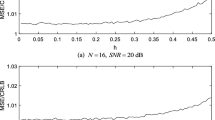Abstract
A direct-sequence spread-spectrum (DSSS) signal has many advantages, such as low SNR and strong anti-jamming ability; thus, it is widely used in various military and civil communication systems. However, hiding and high-data-rate transmission technologies have become the key factors affecting the future applications of the existing DSSS. To solve these problems, an incremental-data stealth-transmission (IDST) method is proposed, which stealthily transmits incremental data through variations in the spread spectrum function and alternation of the weighted fractional Fourier transform modulation order. The incremental data are not transmitted through a real channel but through the function relationship to achieve index transmission. Without affecting the spread spectrum gain and SNR tolerance of the original data, the proposed method greatly improves the amount of information transmitted and enhances the concealment of incremental data.







Similar content being viewed by others
Data availability
Not applicable.
References
Masmoudi, A., Bellili, F., Affes, S., & Ghrayeb, A. (2017). Maximum likelihood time delay estimation from single-and multi-carrier DSSS multipath MIMO transmissions for future 5G networks. IEEE Transactions on Wireless Communications, 16(8), 4851–4865.
Arthaber, H., Faseth, T., & Galler, F. (2015). Spread-spectrum based ranging of passive UHF EPC RFID tags[J]. IEEE Communications Letters, 19(10), 1734–1737.
Tang, L., Zhang, K., Dai, H., Zhu, P., & Liang, Y. C. (2019). Analysis and optimization of ambiguity function in radar-communication integrated systems using MPSK-DSSS. IEEE Wireless Communications Letters, 8(6), 1546–1549.
Qin, X., Qu, F., & Zheng, Y. R. (2019). Circular superposition spread-spectrum transmission for multiple-input multiple-output underwater acoustic communications. IEEE Communications Letters, 23(8), 1385–1388.
Song, M. K., Kim, G., Song, H. Y., & Song, K. W. (2019). Punctured bent function sequences for watermarked DS-CDMA[J]. IEEE Communications Letters, 23(7), 1194–1197.
Yuyao, S., Yongqing, W., Jingyao, C., & Siliang, W. (2015). High sensitivity acquisition algorithm for DSSS signal with data modulation. China Communications, 12(4), 76–85.
Yun, S., Yao, Z., & Lu, M. (2019). Variable update rate carrier tracking loop for time-hopping DSSS signals. IET Radar, Sonar & Navigation, 13(6), 961–968.
Wang, F., Yang, J., Tian, J., Cui, W., & Xiang, J. (2019). Long-time coherent integration for high dynamic DSSS signal. The Journal of Engineering, 2019(21), 7734–7737.
Bottomley, G. E., & Zangi, K. (2017). Direct geolocation of spread-spectrum emitters. IEEE Signal Processing Letters, 24(7), 968–971.
Yao, Z., Guo, F., Ma, J., & Lu, M. (2017). Orthogonality-based generalized multicarrier constant envelope multiplexing for DSSS signals[J]. IEEE Transactions on Aerospace and Electronic Systems, 53(4), 1685–1698.
Bui, D. M., & Lee, S. (2016). Fast gaussian process regression for multiuser detection in DS-CDMA[J]. IEEE Communications Letters, 21(2), 406–409.
Qiu, Z., Peng, H., & Li, T. (2019). A blind despreading and Demodulation method for QPSK-DSSS signal with unknown carrier offset based on matrix subspace analysis[J]. IEEE Access, 7, 125700–125710.
Wu, K., Cosman, P. C., & Milstein, L. B. (2019). Multicarrier DS-CDMA system under fast Rician fading and partial-time partial-band jamming. IEEE Transactions on Communications, 67(10), 7183–7194.
Tayebi, A., Berber, S., & Swain, A. (2018). Security Enhancement of fix chaotic-DSSS in WSNs[J]. IEEE Communications Letters, 22(4), 816–819.
Ouyang, X., Zeng, F., Lv, D., & Wang, W. (2019). Spatial power combining of DSSS signals from a sparse array[J]. IEEE Access, 7, 121863–121873.
Sedaghatnejad, S., & Farhang, M. (2015). Detectability of chaotic direct-sequence spread-spectrum signals. IEEE Wireless Communications Letters, 4(6), 589–592.
Jung, H., Kim, K., Kang, J., Lee, T. S., & Kim, S. (2018). An iALM-ICA-based antijamming DS-CDMA receiver for LMS systems. IEEE Transactions on Aerospace and Electronic Systems, 54(5), 2318-2328.
Savva, G., Manousakis, K., & Ellinas, G. (2019). Eavesdropping-aware routing and spectrum/code allocation in OFDM-Based EONs using spread spectrum techniques[J]. Journal of Optical Communications and Networking, 11(7), 409–421.
Liang, Y., Xiang, X., Sun, Y., Da, X., Li, C., & Yin, L. (2019). Novel modulation recognition for WFRFT-based system using 4th-order cumulants. IEEE Access, 7, 86018-86025.
Mei, L., Sha, X., Ran, Q., & Zhang, N. (2020). Research on the application of 4-weighted fractional Fourier transform in communication system[J]. Science in China Series F (Information Science), 53(6), 1251–1260.
Acknowledgements
This work is supported in part by the National Natural Science Foundation of China (Grant No. 61501309), the Liaoning Natural Science Foundation of China, the Liaoning BaiQianWan Talents Program, and the Liaoning Provincial Colleges and Universities Innovative Talents Support Program.
Author information
Authors and Affiliations
Corresponding author
Ethics declarations
Competing interests
The authors declare that they have no conflict of interests.
Additional information
Publisher's Note
Springer Nature remains neutral with regard to jurisdictional claims in published maps and institutional affiliations.
Rights and permissions
About this article
Cite this article
Liu, F., Liu, J. & Feng, Y. Incremental-data stealth-transmission method in DSSS. Wireless Netw 27, 2441–2449 (2021). https://doi.org/10.1007/s11276-021-02590-6
Accepted:
Published:
Issue Date:
DOI: https://doi.org/10.1007/s11276-021-02590-6




